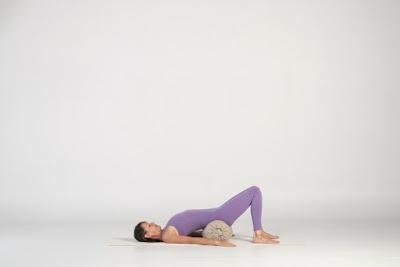
Restorative Bridge Pose by Melina Meza
As I finish up teaching a 200 hour Embodied Mind Training in San Francisco, I have reached the part of the training that I enjoy so much: pulling some threads of yoga practice and Buddhist meditation together in ways that are easily applied and easily practiced by new and advanced practitioners of both alike.One of the best vehicles for restoring the mind is to be in the present moment. This, of course, is easier said than done. When we turn to look inwardly, one of our first observations is how active the mind is, how it rarely lands in the present moment for more than a second or two, and, how random our thoughts can be. By observing the minds fluctuations and returning it to some anchor or supportive “home base” over and over again, we slowly train the unruly mind to stay put for longer and longer periods of time, and with more diverse and sometimes uncomfortable emotions and circumstances. We don’t miss out on huge swaths of our lives; we are more present for it, even the ups and downs.
Many people find that practicing asana before sitting meditation to be very helpful, and I believe the combination of yoga and meditation to be incredibly symbiotic and supportive. Additionally, we can actually meditate in a posture, so that the whole asana practice is meditation in stillness and in motion. We not only can be training our minds to stay in the present moment, but we are training our bodies as well—in all the myriad ways that yoga practice offers.
If you’ve ever taken a restorative yoga class, you know just how valuable they can be. Often we leave a class, or home practice session feeling revived, cleared out, and rested. Each restorative posture addresses some physiological aspect that is slightly unique, each targets different parts of the body, some the mind, some the heart and some our entire package of being.
Usually when we are in a restorative pose, we relax so deeply that we aren’t tethered so much to our bodies. In fact the mind can open into a dream-like state or even fall asleep, which may be some of the reasons that we feel refreshed afterward, like after a nap. But what if as an alternative to sleeping or leaving the body for a time, we draw the mind together with the body to remain relaxed yet awake and bright?
We can accomplish this by making the intention to pay attention while we’re doing whatever we are doing, and that includes when we are in a restorative yoga posture. Each restorative posture calms the central nervous system, so that means that the mind calms as well. With a gradual relaxing of the body and mind, we take advantage of this helping hand to support paying attention, kindly and on purpose, to the breath or sensations rising and falling in the body.
By staying attuned to breath and bodily sensations, we not only are practicing mindfulness of the body, but we are also training the mind to stay in the present moment. On top of that, we are connecting the mind and body, creating a relationship and forging communication that will serve us in many ways.
By deeply listening to body sensations —which really is the wordless language of the body—we get to know its signals. We can interpret what is about to happen, often before it does, because the body will feel a thought or an emotion before it is cognized. It’s somewhat like animals running to higher or safer ground before a natural disaster—their bodies feel the changes and shifts in the earth, wind, seas, light, etc. Normally, we aren’t so in tune with our bodies, but we can certainly gain the skill, and eventually we become sensitive to what is happening inside of ourselves at all times.
This is a wonderful gift because we can then take better care of ourselves, self regulate, and self prescribe (naturally not pharmaceutically) what practice might be the best for that time, or even that we need to relax certain muscles or just take a breath. This way we are responding thoughtfully to the present moment all or most of the time, and taking great care of our body, heart and mind in the process.
So next time you practice a restorative pose, such as the Restorative Bridge pose shown above, try staying bright, clear, and connected. Practice mindfulness of the body by paying close attention to sensations, wherever they are arising and as they pass away. See if the 10 to 20 minutes that you spend in a pose can be 10 to 20 minutes that you are not only benefitting physiologically from the pose, but mentally and emotionally as well. Notice how you feel afterwards. Even try sitting in meditation, on a cushion or a chair, for a few more minutes.
Let’s take full advantage of these two relatable traditions. Let’s support ourselves with care and kindness so we can participate in our lives to the fullest degree possible. And, when called upon to think clearly and respond wisely and compassionately, we will have been preparing the ground beforehand, not wishing we had afterwards. It’s one of our best defenses and gifts, and offered freely on a spiritual path—waking up doesn’t have to be so difficult. Let’s use our traditions and tools to help ourselves and all sentient beings.
Subscribe to Yoga for Healthy Aging by Email ° Follow Yoga for Healthy Aging on Facebook ° Join this site with Google Friend Connect
